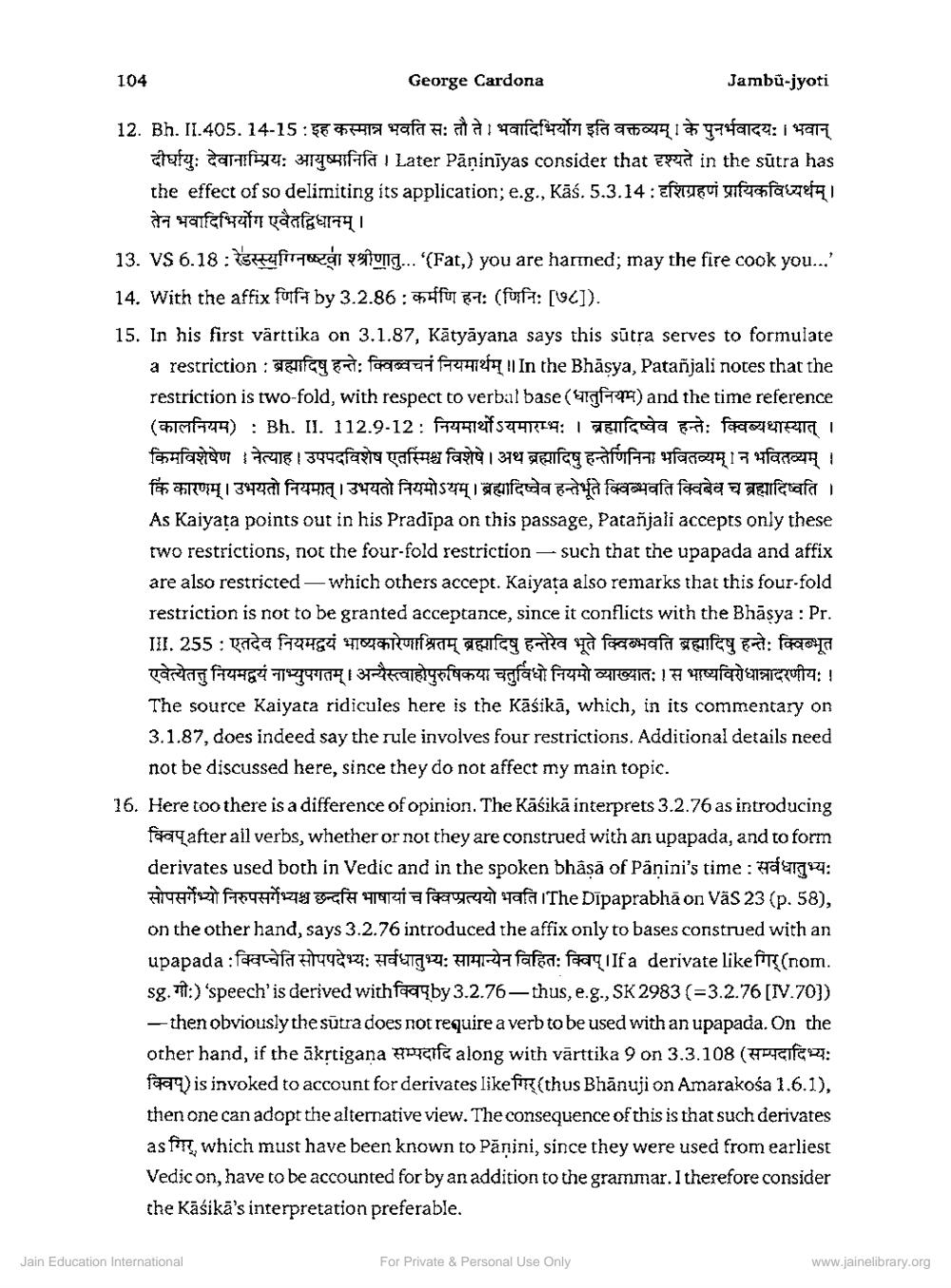________________
104
George Cardona
Jambu-jyoti
12. Bh. II.405.14-15 : इह कस्मान भवति सः तौ ते । भवादिभिर्योग इति वक्तव्यम् । के पुनर्भवादयः । भवान्
दीर्घायः देवानाम्प्रिय: आयुष्मानिति । Later Paniniyas consider that दृश्यते in the sutra has the effect of so delirniting its application;e.g., Kas. 5.3.14 : दृशिग्रहणं प्रायिकविध्यर्थम् ।
तेन भवादिभिर्योग एवैतद्विधानम् । 13. VS 6.18 : रेडस्स्यग्निष्ट्वा श्श्रीणातु... (Fat,) you are harmed; may the fire cook you...' 14. With the affix णिनि bv3.2.86: कर्मणि हनः (णिनिः ७ि८).
15. In his first värttika on 3.1.87, Kātyāyana says this sūtra serves to formulate
a restriction : ब्रह्मादिषु हन्तेः क्विब्वचनं नियमार्थम् ॥ In the Bhasya, Patanjali notes that the restriction is two-fold, with respect to verbal base (479fm) and the time reference (कालनियम) : Bh. II. 112.9.12 : नियमार्थोऽयमारम्भः । ब्रह्मादिष्वेव हन्तेः क्विब्यथास्यात् । किमविशेषेण । नेत्याह। उपपदविशेष एतस्मिंश्च विशेषे। अथ ब्रह्मादिषु हन्तेणिनिना भवितव्यम् । न भवितव्यम् । कि कारणम्। उभयतो नियमात्। उभयतो नियमोऽयम्। ब्रह्मादिष्वेव हन्तेर्भूते क्विब्भवति क्विबेव च ब्रह्मादिष्वति । As Kaiyata points out in his Pradīpa on this passage, Patañjali accepts only these two restrictions, not the four-fold restriction - such that the upapada and affix are also restricted-which others accept. Kaiyata also remarks that this four-fold restriction is not to be granted acceptance, since it conflicts with the Bhāsya : Pr. III. 255: एतदेव नियमद्वयं भाष्यकारेणाश्रितम् ब्रह्मदिषु हन्तेरेव भूते क्विब्भवति ब्रह्मादिषु हन्तेः क्विब्भूत एवेत्येतत्तु नियमद्वयं नाभ्युपगतम्। अन्यस्त्वाहोपुरुषिकया चतुर्विधो नियमो व्याख्यातः । स भाष्यविरोधान्नादरणीयः । The source Kaiyata ridicules here is the Kāśikā, which, in its commentary on 3.1.87, does indeed say the rule involves four restrictions. Additional details need not be discussed here, since they do not affect my main topic.
16. Here too there is a difference of opinion. The Kāśikā interprets 3.2.76 as introducing
faqafter all verbs, whether or not they are construed with an upapada, and to form derivates used both in Vedic and in the spoken bhāsa of Panini's time : सर्वधातुभ्यः सोपसर्गेभ्यो निरुपसर्गेभ्यश्च छन्दसि भाषायां च क्विप्प्रत्ययो भवति। The Dipaprabha on Vas 23 (p. 58), on the other hand, says 3.2.76 introduced the affix only to bases construed with an upapada :क्विप्चेति सोपपदेभ्यः सर्वधातुभ्य: सामान्येन विहित: क्विप्|If a derivate likeगिर् (nom. sg. :) 'speech' is derived with feqyby 3.2.76— thus, e.g., SK 2983 (=3.2.76 [IV.70]) - then obviously the sūtra does not require a verb to be used with an upapada. On the other hand, if the akrtigana सम्पदादि along with varttika9on 3.3.108 (सम्पदादिभ्यः f99) is invoked to account for derivates like fire (thus Bhānuji on Amarakośa 1.6.1), then one can adopt the alternative view. The consequence of this is that such derivates as fire, which must have been known to Panini, since they were used from earliest Vedicon, have to be accounted for by an addition to the grammar. I therefore consider the Kāśikā's interpretation preferable.
Jain Education International
For Private & Personal Use Only
www.jainelibrary.org




